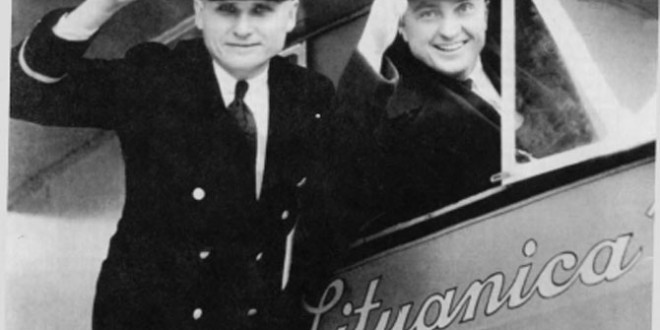BY JOHN MILLAR

Almost 70 years later, the true cause of the fateful crash of the “Lituanica” and the death of its two pilots remains an unsolved mystery.
IN THE YEAR 1993 LIETUVOS BANKAS, Lithuania’s National Bank, issued a Treasury note, valued at 10 litas, on the face of which appeared a head and shoulders portrait of two young men in uniform. Their names were shown as S. Darius and S. Girenas. Why were these two young men given the honor of appearing on their country’s currency? Who were they? Why were they so honored? Had they perhaps performed some particular deed which had made them national heroes? The reverse side of the 10 litas note supplies a clue. Apart from the value of the note in words and figures and a small portrayal of Vytis, the entire reverse side depicts a single-engine, high-wing monoplane with fixed undercarriage in the middle of the Atlantic Ocean between the continents of N orth America and Europe. The aircraft is shown heading away from America towards Europe. Were Darius and Girenas therefore pilots of a particularly special aircraft or flight? Yes! Indeed! The currency note had been issued to commemorate the sixtieth anniversary of that 1933 flight and the story of Darius and Girenas, and their journey contains all the elements of suspense, heroism and mystery found in a classic tale of fiction.
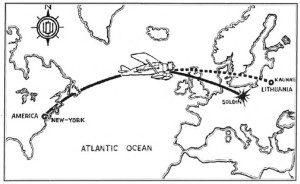
Steponas (Stephen) Darius (formerly Jucevicius) was born 9 December 1897 in the village of Rubiškes, Taurage district of Lithuania. At 10 years of age he and his family, like thousands of their fellow Lithuanians, were in the United States of America. By October 1917 Darius was in France, in uniform, and in 1919-20 he was back in his Lithuanian homeland, where, by 1923 he was a lieutenant in his country’s fledgling air force. He returned to the USA and on 19 September 1927 obtained his pilot’s license from the National Aeronautical Association of the United States of America. An interesting historical point— one of the signatures on his pilot’s license is that of Orville Wright.
Stasys (Stanley) Tomas Girenas (formerly Girskis) was born 15 October 1894 in the village of Vytogala, Raseiniai district of Lithuania. He was the sixteenth child of whom only four in the family survived to adulthood. W ith his older brother he emigrated to the USA in 1910. Always of a technical mind he ended his First World War service as a skilled aircraft mechanic who could also fly the planes he serviced. It was probably inevitable that Darius and Girenas should meet and become friends. The post-First World War aviation world was still comparatively small and immigrant Lithuanian flyers were essentially a tiny part of the flying circus. Being fellow Lithuanians naturally helped to cement their friendship and it was not long before they were planning how to put their flying skills to the benefit of their native land.
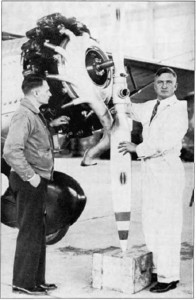
Alcock and Brown, in June 1919, had shown that airflight across the Atlantic Ocean was possible and Charles Lindbergh had successfully completed the first solo Transatlantic flight when he landed near Paris, France on 21 May 1927. Every country’s pioneer flyers were now keen to prove there was no limit to air travel.
So it was also with Darius and Girenas. With the aid of the Lithuanian American community, who subscribed in every possible manner, they purchased an aircraft, which they named “Lituanica.” The plane was a single-engine, high-wing monoplane 8.45 meters in length with a wing span of 15.24 meters. It had a top speed of 249 kilometers per hour, a cruising speed of 180 kilometers per hour and fully laden a ceiling of some 20,000 feet. With the various modifications made by or on the instructions of Darius and Girenas, which included considerably enlarging the fuel capacity, the range of the plane was increased to approximately 10,000 kilometers and under good flying conditions this would give a total flying time of some 50 hours. Darius and Girenas now planned to fly “Lituanica” nonstop from New York, USA to Kaunas, Lithuania and also undertake a return flight.
After flying from Chicago, “Lituanica” landed at Floyd Bennett Airfield, Brooklyn, New York on 8 May 1933 from which airfield it would take off for Lithuania. Adverse meteorological reports and various other reasons kept the aircraft earthbound until 15 July 1933 when eventually, at 6:24 a.m., the plane became airborne on its epic journey, one and a quarter hours after Wiley Post. (Wiley Post successfully flew round the world in 7 days, 18 hours and 49 minutes.) “Lituanica” was very heavily laden— so much so that it had barely 50 meters to spare before the end of the runway on takeoff.
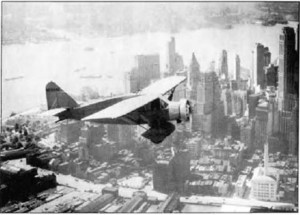
The plane had no radio but confirmation that it was on course was made at Newfoundland where a red bag was dropped from “Lituanica” with the message “15 July, 5:10 p.m. We were here”— and also over the Atlantic when a ship, some 250-300 miles west of Ireland, reported seeing the plane about 11:20 a.m. on 16 July.
Nothing more was heard about the aircraft for the next 12 hours until news filtered through that a plane had crashed in a German forest, near the Polish border, at 36 minutes past midnight on 17 July. The forest was near the village of Kudamo, some 7-8 kilometers from Soldin, a town of about 6,500 inhabitants in the province of Brandenburg, 120 kilometers from Berlin.
Both pilots were dead when the wreckage was discovered by a woman (Ana Rosenthal) from the village of Kudamo who had been mushroom-gathering with her two daughters around 4:45 a.m. According to her statement: “I can’t remember the exact time when I saw the wrecked aircraft and the two bodies. On seeing them I sent my 14-year-old daughter (Frieda) to run back to the village and ask our neighbor (Zimmerman) to telephone the authorities. Not long after some of the villagers arrived including the village headman (Maerten) who asked the people not to go too near to the bodies of the flyers.”
This was the statement Ana Rosenthal supposedly made that day (17 July 1933) to Major Hatendorf of the German Air Force Police. Many years later, a Lithuanian newspaper (Aušra) published an excerpt from a 1933 edition of the German daily newspaper Pommeranische Zeitung which quoted the statement of Ana Rosenthal as:
“When we were going into the forest it was not quite daylight when I saw among the trees a red fabric and pieces of material scattered everywhere. When I saw the body of a man I was very much afraid. I realized that some terrible thing had happened and was loth to go any nearer, so I ran, with my daughters back to the village where I told my husband and some other people. We all returned to the forest and saw the terrible scene. The airplane had fallen on its side and in the pilot’s place sat a man in blue overalls. The top half of his body hung towards the ground, one hand across his forehead as if to protect it. W hen we went close we saw that he was dead. Beside him, on the ground, lay the body of a second man also dressed in blue overalls. It looked as if he had been thrown out of the pilot’s place when the plane had fallen. He was also dead.”
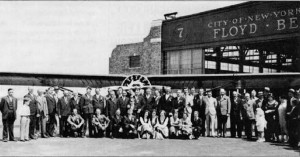
Despite the crash scene being ringed by German civilian and Air Force police, crowds of people tramped through the area and began taking parts of the aircraft and its contents as souvenirs without apparently any police restriction or interference in their scavenging.
Speculation on the reason(s) why “Lituanica” crashed such a comparatively short way from its intended landing place after successfully mastering the Atlantic Ocean were fueled by various peculiar— even suspicious— acts by the German authorities. In addition to allowing the souvenir hunters more or less carte blanche, there was a delay in notifying the Lithuanian Embassy in Berlin about the crash and the death of the two Lithuanian flyers. The Germans did not await the arrival of Lithuanian officials at the crash site but removed the bodies of Darius and Girenas to the crematorium at Soldin and collected the remaining parts of the aircraft into a pile. When the plane parts were handed over to the Lithuanian authorities, their examination gave no indication of the cause of the crash. Important missing parts were blamed on souvenir hunters!
It was not until three days after the crash, on 20 July, that the Germans gave the Lithuanian Embassy the diary, logbook, notebooks, maps and pilots’ licenses they had removed from the plane. The last entry in the diary was 13 July 1933— all the succeeding pages had been torn out.
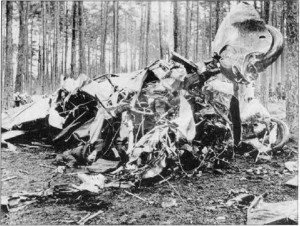
Rumors, suspicion and speculation grew as to why the “Lituanica” had crashed:
• The aircraft was running very low on fuel and the pilot was looking for a landing place.
• It was a dark and stormy night with lighting and heavy rain forcing the plane to fly very low. Perhaps the undercarriage caught the top of a pine tree.
• After so long in the air (31 hours 11 minutes) both men were exhausted and the crash was a result of fatigue and pilot error.
• An eyewitness said the plane came from the east. Was it circling for the pilot to find his bearings and flew too low?
• The greatest rumor and speculation of all: The German Military had shot the plane down!
What did the German authorities have to say about the whys and wherefores of the crash? After all, it was their officials and police who were on the site first after the Kudamo villagers.
Major Hatendorf made the official report in which he said that the German Air Force police at Tem plehof Airport, Berlin, knew nothing of the flight, had not received any official information or notification that Darius and Girenas were attempting to fly from America to Europe. That the aircraft must have reached Europe after dark on a night of storm with low heavy clouds which probably caused the plane to drift from its intended course into German territory. He reckoned with only a maximum of fifteen minutes fuel left in their tanks, the pilot was in a hurry to find a landing place. Only 100 yards from the crash site was a flat, level area. Thus the official German view was that the plane was illegally in German airspace and fuel shortage and pilot error caused the crash.
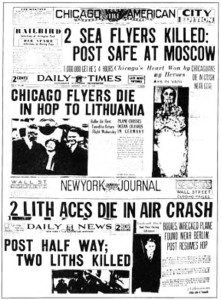
The shortage of fuel theory was discounted by a Lithuanian expert who claimed that at the time of the crash there was still enough fuel for four hours flying in the tanks. At takeoff “Lituanica” had been loaded with fuel for 37 hours flying and it had been in the air just over 31 hours.
Did the German military shoot down Darius and Girenas? Because of their actions subsequent to the crash, suspicions had been aroused throughout Europe. Certainly the general opinion in Kaunas— and the rest of Lithuania— was that they had done so. Elsewhere newspapers were voicing their opinion.
On 24 July 1933 the Strasbourg journal Les Demieres Nouvelles asked and answered the question: “Were the Lithuanian flyers Darius and Girenas shot down by German guns? It is a proven fact that on the German-Polish border there are antiaircraft weapons situated and the troops stationed there have orders to shoot down any aircraft flying over German territory.”
Rumors of bullet holes in the plane and of bullets actually found were rife. However the parts which were returned to Lithuanian authorities had no holes corresponding to that made by bullets or other missiles and any bullets that were found had disappeared, probably credited to souvenir hunters.
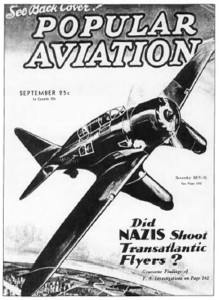
The French newspaper L’Intransigent claimed that on the body of Girenas wounds were found consistent with him having been shot. When a journalist asked Professor J. Žilinskas, who undertook the postmortem examinations, if he had found any bullets or evidence that either or both Darius and Girenas had been shot, he is supposed to have relied, rather ambiguously, “I am not saying that I have found nothing.” He is also reported as having told the widow of Darius that, “if it had not been for the Germans our men would have arrived.”
German press reports hinted that “Lituanica’s” flight over German territory had military reasons. Apparently not far distant from the crash site was a concentration camp which was always brilliantly illuminated during the hours of darkness and, as seems probable, if the plane had drifted from its planned course it would be logical for a pilot to circle a lit-up area in order to ascertain his position. During this manoeuver the plane would at one point in the circle be flying east to west.
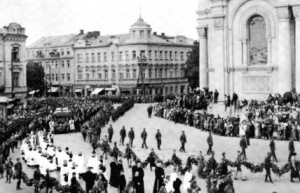
An eyewitness stated that the airplane fell from the sky with “a loud bang.” “On 17 July 1933 about half-past midnight I was standing about 50 meters from our farm when I heard an aircraft from the north. The plane, with one white light, came over Kudamo, swung south and then turned east. I then lost sight of it but still heard its engine. After maybe two minutes there was a terrific bang. I could not place the location but from the fact that the engine sound had stopped I knew the plane had fallen.”
Like all unsolved mysteries, the solution to the plane crash in which Darius and Girenas lost their lives demands answers to a series of vital questions. It must be remembered that this tragedy occurred in the first year of the Hitler National Socialist regime whose totalitarian authority tended to prevent the spread of information. One intriguing aspect is that there is nothing in any of the official reports that cites mechanical failure of the airplane as a cause of the crash.
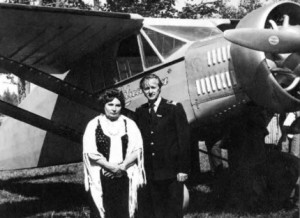
 DRAUGAS NEWS Lithuanian World Wide News in English
DRAUGAS NEWS Lithuanian World Wide News in English
